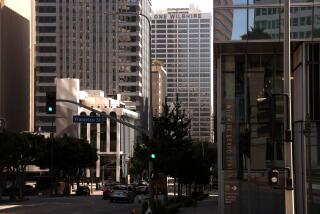Valley Vacancies Rise as Show Biz Softens
The market for office space in the San Fernando Valley and Pasadena appears to be cooling, with vacancy rates rising as an expected boom in entertainment usage has thus far failed to materialize, according to real estate experts and two reports released Monday.
In the prime office markets of Burbank, Glendale and Pasadena, the vacancy rate at the end of September was 12%, up more than two percentage points from mid-1997, according to the third quarter report from Cushman Realty Corp., a Los Angeles-based real estate brokerage.
Since the first half of 1997, the amount of vacant office space available has increased by 300,000 “rentable” square feet, the report showed.
“That’s not a positive sign,” said Andrew Ratner, Cushman’s executive vice president. “The amount of square footage in the marketplace has remained fairly stable, but the total amount of occupied square footage has fallen.”
Still, “the market is stronger than the press is giving it credit for,” said Ratner, Cushman’s national director for real estate services.
Technology, Service Industries Step Up
Even though entertainment leasing has not proved the great savior some had hoped for, tenants in the technology and service sectors are stepping into the void, experts said.
“Technology is still moving ahead,” said Maya Mouawad, manager of research services for Marcus & Millichap, a Palo Alto-based real estate brokerage that specializes in investment properties. “But I’m not sure it’s going to move ahead at a pace where it’s going to compensate for the decline in entertainment.”
Marcus & Millichap’s report on the first half of 1998, which also was released Monday, put the office vacancy rate at 11.5% for the Valley region, including Glendale, Burbank and Pasadena.
One highly visible symbol of the pullback in entertainment, according to Ratner, is the 24-story Glendale Plaza, the ongoing project of Los Angeles-based developer PacTen Partners, which has yet to announce a major lease signing. The developer said Monday that a deal should be announced by year’s end for the building that will open in five months.
Entertainment Dreams Bring Vacant Reality
“When they built this, they expected it to be nearly all entertainment,” Ratner said. “But the demand they expected to be there is not there. There’s been zero entertainment demand.”
Dennis Fitzpatrick, a partner with PacTen, declined to classify the current state of affairs in entertainment as a slowdown but added, “I will grant you that I’m not aware of any big transactions that have taken place in the past several months in entertainment” leasing.
“In our overall assessment of the market, we thought that entertainment would represent a significant, but not overpowering part of the market,” he said. “We still see entertainment being a significant part of the market. . . . The market is not devoid of entertainment kinds of tenants.”
Mouawad said the slowdown in the office market began in the second quarter of this year and is at least in part a symptom of the Asian economic crisis.
“With the recession in Asia and the almost collapse of the Russian economy, those are two big markets,” said Mouawad. “Those are our export markets.”
She said a decline in exports eventually will translate into slower job growth. The Marcus & Millichap report forecasts 1998 job growth of 2.6% countywide and 2.7% in the Valley over 1997. That’s on par with the Valley’s 2.7% growth in 1997, but down from the 3.5% growth in 1996.
“The office sector is mostly driven by employment,” Mouawad said. “When that sector is not expanding as much, the office sector is one of the first [areas] to feel it.”
In addition to curtailed exports, Mouawad said the turmoil in Asia reduces the investment capital the entertainment industry might otherwise use to expand.
On the plus side, the Marcus & Millichap report highlights development along the Ventura Boulevard corridor, which is described as “perhaps the most diversified sub-market” in the region.
In addition, vacancy rates in Warner Center dropped 3.8 percentage points from the first quarter of 1997 to the first quarter of 1998.
And the Cushman report notes that “investment activity continued to be very active, as [five] office buildings traded hands.”
Looking ahead six months, Mouawad said, “we see more of a leveling off. We don’t see any signs of a dramatic change, but we do see signs of a slowdown. . . . It’s already started.”
More to Read
Inside the business of entertainment
The Wide Shot brings you news, analysis and insights on everything from streaming wars to production — and what it all means for the future.
You may occasionally receive promotional content from the Los Angeles Times.










